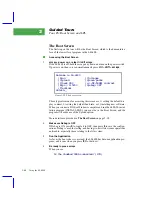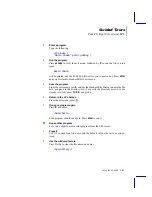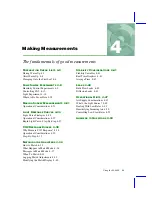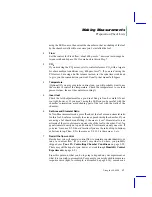
Making Measurements
Some Simple Experiments
4-8
Using the LI-6400
4
vey measurements (page 4-21), going from leaf to leaf and only taking a
minute or so to get each measurement.
If you are new to gas exchange measurements on plants, continue on with the
next section (
). It will take you through some
things to look for to make sure you are making a valid measurement.
Some Simple Experiments
If you have not had much experience making gas exchange measurements be-
fore, you may wish to work through some of the experiments in this section.
To do any of them, however, first get a leaf established in the chamber:
■
■
■
■
Do this first
1
Select a plant and leaf to measure
The easiest measurement will be on an adequately watered plant that is grow-
ing in full or partial sun. By contrast, a difficult measurement will be on a dry,
neglected house plant that has only seen dim (for the plant) fluorescent lights
its whole life. Try to find something more like the former than the latter.
2
Do Steps 1 through 6 in the previous section
This will take you through getting the leaf into the chamber.
3
Observe the CO
2
concentrations
Note
CO2S_µml
. Is it below
CO2R_µml
? If so, thatÕs good, because it means
photosynthesis is occurring. (Photosynthetic rate will be on display line
c
, un-
der
Photo
.) Is
CO2S_µml
stable (within 0.2 or 0.3 µmol mol
-1
)? It should sta-
bilize after 30 seconds or so of clamping onto the leaf. If itÕs not stable, check
CO2R_µml
for stability. Perhaps the mixer isnÕt stabilized yet, or you need a
buffer volume. Consult
you need help fixing this instability. If
CO2S_µml
is not below
CO2R_µml
,
then perhaps you need to match (page 4-34).
4
Observe the humidity values
The
RH_S_%
value on display line
b
is the relative humidity in the sample
IRGA. ItÕs calculated from the water IRGA signal, which is
H2OS_mml
. Oth-
er things being equal, you want to make gas exchange measurements in as
high a humidity as possible, without letting the flow rate (which is determin-
ing that humidity) go too low. 200 or 300 µmol s
-1
is a reasonably low flow
range; but you can drop to 100 if you need to. (Leaks are a bigger problem at
low flow rates - see
You are now ready to do some or all of the following elementary experiments.
Summary of Contents for LI-6400
Page 1: ...Using the LI 6400 Portable Photosynthesis System ...
Page 15: ...Part I The Basics ...
Page 16: ......
Page 174: ...Making Measurements Answers to Questions 4 56 Using the LI 6400 4 ...
Page 175: ...Part II Useful Details ...
Page 176: ......
Page 200: ...Standard Tools Power ON Hooks 5 24 Using the LI 6400 5 ...
Page 214: ...Real Time Data Real Time Graphics 6 14 Using the LI 6400 6 ...
Page 234: ...Environmental Control Light Control 7 20 Using the LI 6400 7 ...
Page 244: ...Light Sensor Considerations Gallium Arsenide Phosphide GaAsP Sensor 8 10 Using the LI 6400 8 ...
Page 288: ...Data Logging Making Your Own AutoPrograms 9 44 Using the LI 6400 9 ...
Page 289: ...Part III Working With Files ...
Page 290: ......
Page 312: ...The LPL File System Troubleshooting 10 22 Using the LI 6400 10 ...
Page 340: ...Downloading Files Using a Data Capture Program 11 28 Using the LI 6400 11 ...
Page 375: ...Part IV Configuration Issues ...
Page 376: ......
Page 420: ...Defining User Variables Old Style vs New Style 15 18 Using the LI 6400 15 ...
Page 454: ...Using an Energy Balance Further Reading 17 12 Using the LI 6400 17 ...
Page 455: ...Part V Maintenance Troubleshooting ...
Page 456: ......
Page 572: ...Troubleshooting Useful Information 20 46 Using the LI 6400 20 ...
Page 593: ...Part VI Programming ...
Page 594: ......
Page 622: ...Programming with LPL Compiler Directives 22 28 Using the LI 6400 22 ...
Page 846: ...Index I 16 Using the LI 6400 ...
















































